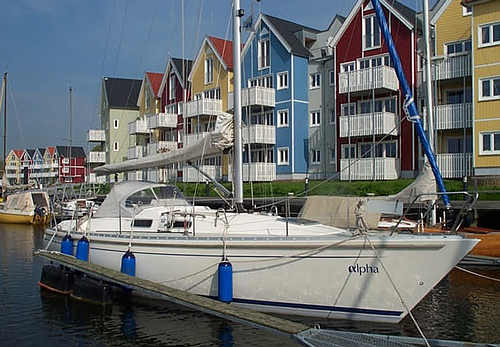Review of Hanse 331

Basic specs.

Looking for a new boat? Find a Hanse 331 or similar boat for sale
The hull is a double hull which improves the indoor climate. Especially when the water is colder than the air in the cabin, then the double hull insulates against cold water and reduce the condense water in the cabin.
The boat is equipped with 3 cabins, 6 berths, a galley and toilet facility.
The Hanse 331 has been built with more than one type of keel.
One option is a fin keel. A boat with a fin keel is more manoeuvrable but has less directional stability than a similar boat with a long keel.But be aware that even though a Wing Keel keel is very good for speed racing, a fishing nets and the like in the water can easily make you into a troublesome situation.
The boat is typically equipped with an inboard Volvo Penta MD2020 diesel engine at 19.0 hp (14 kW), which gives a max speed about 5.3 knots.
The fuel tank has a capacity of 50.0 liters (13 US gallons, 10 imperial gallons).
Sailing characteristics
This section covers widely used rules of thumb to describe the sailing characteristics. Please note that even though the calculations are correct, the interpretation of the results might not be valid for extreme boats.
What is Capsize Screening Formula (CSF)?
The capsize screening value for Hanse 331 is 1.88, indicating that this boat could - if evaluated by this formula alone - be accepted to participate in ocean races.
Hanse 331 holds one CE certification:
The boat is by European Union certified as Class A. OCEAN:What is Theoretical Maximum Hull Speed?
The theoretical maximal speed of a displacement boat of this length is 7.0 knots. The term "Theoretical Maximum Hull Speed" is widely used even though a boat can sail faster. The term shall be interpreted as above the theoretical speed a great additional power is necessary for a small gain in speed.
The immersion rate is defined as the weight required to sink the boat a certain level.
The immersion rate for Hanse 331 is about 169 kg/cm, alternatively 947 lbs/inch.
Meaning: if you load 169 kg cargo on the boat then it will sink 1 cm.
Alternatively, if you load 947 lbs cargo on the boat it will sink 1 inch.
Sailing statistics
This section is statistical comparison with similar boats of the same category. The basis of the following statistical computations is our unique database with more than 26,000 different boat types and 350,000 data points.
What is Motion Comfort Ratio (MCR)?
The Motion Comfort Ratio for Hanse 331 is 24.3.
What is L/B (Length Beam Ratio)?
The l/b ratio for Hanse 331 is 3.27.
What is Displacement Length Ratio?
The DL-ratio for Hanse 331 is 227 which categorizes this boat among 'light crusers & offshore racers'.
What is Relative Speed Performance?
The Relative Speed Performance for Hanse 331 is 88
Maintenance
If you need to renew parts of your running rig and is not quite sure of the dimensions, you may find the estimates computed below useful.
| Usage | Length | Diameter | ||
| Jib sheet | 10.1 m | (33.1 feet) | 12 mm | (1/2 inch) |
| Genoa sheet | 10.1 m | (33.1 feet) | 12 mm | (1/2 inch) |
| Mainsheet | 25.2 m | (82.7 feet) | 12 mm | (1/2 inch) |
| Spinnaker sheet | 22.2 m | (72.8 feet) | 12 mm | (1/2 inch) |
This section shown boat owner's changes, improvements, etc. Here you might find inspiration for your boat.
Do you have changes/improvements you would like to share? Upload a photo and describe what to look for.
We are always looking for new photos. If you can contribute with photos for Hanse 331 it would be a great help.
If you have any comments to the review, improvement suggestions, or the like, feel free to contact us. Criticism helps us to improve.
